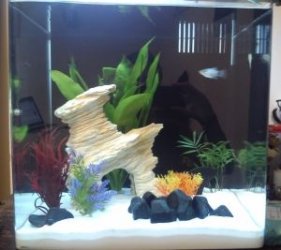
Hi guys, i would appreciate a little advice on my new tank as it is my first
So i have had my Tank for 6 weeks for and i have been testing the water with the proper test kits (not strips) and has always been around PH - 7.4
Ammonia - 0.25
Nitrates - 0
I do about 20 % water change a week and as you can see i have two mickey platies,
I did originally have 4, i got them a week after i had set up my tank and i had been using the denitrol stuff to speed up the bacterial growth and as advised by the pet store i should be fine with my platies.
However the other two orange ones have died, the first (male) died after 48 hours and the other a couple of weeks after. I was testing the water and everything was fine and the other two silver ones are so hyperactive ( even jumping out of the tank haha) i wondered why the other two had not made it.
I wondered maybe they where bad fish? I got them from a good store (Abyss in Stockport.. im always a little nervous about ones from pets at home no one who works there seems to know what they are on about).
Anyway i was wondering if i could start introducing other fishes? even if ammonia is 0.25... altho it doesn't seem to change and what fish i should get. I was looking at corys... or rams..altho i don't think my tank is big enough for a couple of rams? Or a school of tetras (small ones)
Also are the two platies ok with just two of them now... or should i considering getting more for company. I just want to be careful about overstocking.
And with a tank this size .. does it harm do a couple of water changes a week...or should i stick to 20% a week?
